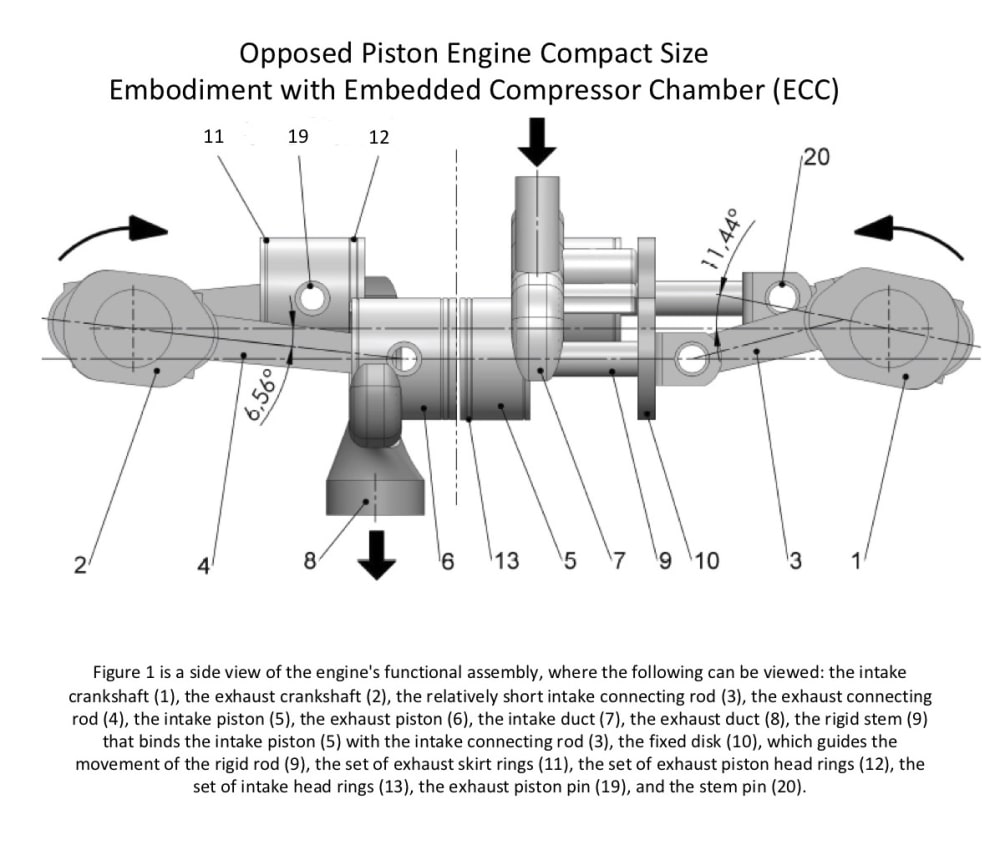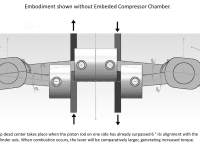This innovation relates to the field of opposed piston internal combustion engines (OP-ICE) having two pistons in one cylinder configured to have facing heads. Specifically, this engine (herein “the Engine”) architecture shows the following features relative to a comparable design:
- Compact size: The new architecture solves a size issue, allowing the width of the engine block to be reduced by 30% and thus installed in a horizontal position, maintaining a low center of gravity as well as proper balance and lubrication of the mechanical assembly, even in compact vehicles.
- Improved performance: the design allows an improved angular position of the crankshaft journal relative to the cylinder axis at the moment of maximum compression. The better angle of the lever arm at the moment of fuel combustion results in an improvement in torque.
- Volumetrically self-sufficient: In certain embodiments, this invention dispenses the need for an external compressor because the design includes, an embedded compressor chamber through a new piston and cylinder combination. The engine enables the performance of the entire typical thermodynamic cycle of admission, compression, combustion, and exhaust, and a compression that meets the volumetric requirements, including exhaust gas sweeping and overload in the cylinder for each revolution.
In terms of OP-ICE manufacturability, it’s worth quoting Achates Power qualified opinion in the field: “… Opposed-Piston Engine uses standard materials and processes, it can take advantage of the common manufacturing methods, tools and facilities currently employed by OEMs around the world. With a relatively modest re-tooling expense, the opposed-piston engine can be produced in existing engine manufacturing plants. Existing components can be modified for use in opposed-piston engines. A recent study by FEV concludes that OP engines are 11% less expensive than conventional engines of the same power and torque. The OP engine design saves in reduced aftertreatment system size and expense (due to the inherently low NOx capabilities of the architecture) and by eliminating the cylinder head and valve train. The OP engine is more efficient, sets new benchmarks in low emissions, and is less expensive to build.”
Climate Change urges us to urgently neutralize emissions from all sectors. The automotive industry is committed to reduce polluting emissions from vehicles during transition to net zero emissions and experts have defined that: powertrain electrification; next generation ICE; disruptive aftertreatment systems and cleaner fuels, are the efficiency vectors.
In recent years, several assessments have been conducted on opposed piston engines applications. The outstanding efficiency achieved are driving OP-ICE to industrial scale in the hands of leading manufacturers, for military and heavy-duty operations.
Since always, when a technology in the automotive field results in a cost-efficient solution, it is massively adopted for the benefit of all fleets.
Due to the fact that two opposing pistons share the same cylinder, the OP ICE architecture has eventually been criticized for being "too expansive" to fit in any vehicle.
The Engine evolution overcomes space restrictions for proper fitting of the OP-ICE arrangement in light duty and all size vehicles.
Video
Like this entry?
-
About the Entrant
- Name:Carlos Juni
- Type of entry:individual
- Software used for this entry:Solid Works
- Patent status:patented








